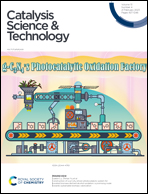A trifunctional N-doped activated carbon–ceria shell, derived from covalent porphyrin polymers for promoting Pt activity in fuel cell cathode performance†
Abstract
Developing an active, durable and cost-effective air cathode catalyst is critical for commercializing proton exchange membrane fuel cells (PEMFCs). CeO2 has been reported as a scavenger of harmful peroxide by-products, yet it is less efficient in O2 electrocatalysis due to its insufficient electronic conductivity. In this work, a novel approach is proposed to mitigate this limitation. We prepared CeO2 nanoparticles incorporated into a porous organic polymer (POP) followed by pyrolysis with KOH to form a mixed phase of ceria and CeCx incorporated in a conducting nitrogen-doped carbon matrix (CeCx/N-doped carbon), exhibiting high porosity (1320 m2 g−1) and specific capacitance (37.7 F cm−2). Pt nanoparticles impregnated onto CeCx/N-doped carbon revealed preferential binding and nucleation with the support offering enhanced oxygen reduction reaction (ORR) activity in acid and alkaline electrolytes. Structural characterization by XRD, TEM, and XPS discloses a successful synthesis of a composite hybrid catalyst comprising Pt on CeCx and N-doped activated carbon, designated as Pt/KC@CeO2. The ORR activity in 0.5 M H2SO4 shows a higher onset (0.84 V/RHE) and limiting current density, −3.5 mA cm−2, comparable with that of commercial Pt/C. Importantly, Pt/KC@CeO2 exhibits a low peroxide yield (<1%, 0.6 V, RHE) and strong kinetics (Tafel value = −66 mV dec−1) together with 4e− transfer to O2 that signifies Pt–support interaction. An accelerated durability stress test (ADST) shows negligible loss of non-faradaic current with a minimum shift (∼60 mV) in the onset potential after 5000 potential cycles, exhibiting the better durability of Pt/KC@CeO2 in an acid electrolyte. Pt/KC@CeO2 as a cathode catalyst in a H2/O2 PEMFC provided superior peak power density (0.785 W cm−2) compared to Pt/CeO2 (0.403 W cm−2) and Pt/C (0.613 W cm−2), indicating that Pt stabilized by cerium carbide containing N-doped carbon could be an interesting electrocatalyst for advanced energy research.



 Please wait while we load your content...
Please wait while we load your content...